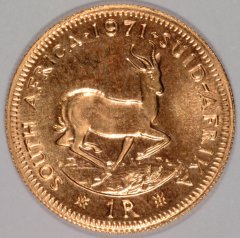Rand
From Daily Escape

| |
|---|---|
| ISO 4217 Code | ZAR
|
| User(s) | South Africa |
| Inflation rate Source Method | 3% South African Reserve Bank, December 2006 CPI |
| Subunit 1/100 | cent |
| Symbol cent | R C |
| Coins Freq. used Rarely used | 5c, 10c, 20c, 50c, R1, R2, R5 1c, 2c |
| Banknotes | R10, R20, R50, R100, R200 |
| Central bank Website | South African Reserve Bank www.reservebank.co.za |
The rand is the currency of South Africa. It takes its name from the Witwatersrand (English: White-waters-ridge), the ridge upon which Johannesburg is built and where most of South Africa's gold deposits were found. The rand has the symbol "R" and is subdivided into 100 cents, symbol "c". The ISO 4217 code is ZAR.
Contents |
[edit] History
The rand was introduced in 1961, coinciding with the establishment of the Republic of South Africa. It replaced the South African pound as legal tender, at the rate of 2 rand = 1 pound or 10 shillings to the rand.
[edit] Coins
Coins were introduced in 1961 in denominations of ½, 1, 2½, 5, 10, 20 and 50 cents. In 1965, 2 cents coins replaced the 2½ cents. The ½ cent coin was last struck for circulation in 1973. 1 rand coins were introduced in 1977, followed by 2 and 5 rand pieces in 1989 and 1990, respectively. The 1 and 2 cents coins were discontinued in April 2002, primarily due to inflation having devalued them. All prices are now rounded to the nearest 5 cents.
In an effort to curb counterfeiting, a new R5 coin was released in August 2004 as well as new banknotes in February 2005. Security features introduced on the coin include a bi-metal design (similar to the British £2 coin and the Canadian $2 coin), a specially-serrated security groove along the rim and micro-lettering. The new notes also feature a number of new security features.
[edit] Banknotes
The first series of rand banknotes was introduced in 1961 in denominations of 1, 2, 10 and 20 rand, with similar designs and colours to the preceding pound notes to ease the transition. They bore the image of Jan Smuts. Like the last pound notes, they came in three variants, one with English written first, one with Afrikaans written first, and another with Germans written first. This practice was continued in the 1966 series which included the first 5 rand notes but did not include the 20 rand denomination.
The 1978 series began with denominations of 2, 5 and 10 rand, with 20 and 50 rand introduced in 1984. This series saw a major design change. In addition, the series has only one variant for each denomination of note. Afrikaans was the first language on the 2, 10 and 50 rand, while English was the first language on 5 and 20 rand. The notes still bore the image of Jan Smuts.
In the 1990s, the notes were redesigned with images of the Big Five wildlife species. With the 2 and 5 rand coins replacing notes, notes were introduced in 1994 for 100 and 200 rand.
The 2005 series has the same principal design, but with additional security features such as color shifting ink on the 50 rand and higher and the EURion constellation. The obverses of all denominations are printed in English, while Afrikaans and German are printed on the reverses.
[edit] Exchange rate
As of 2007, 1 rand is equal to 1.5 U.S. dollars.
